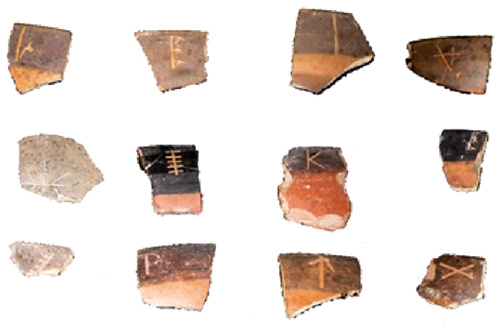
. > WHAT'S NEW > RESEARCH
Origin of Chinese scripts key to studying early civilization
Author : LU HANG Source : Chinese Social Sciences Today 2020-07-25

Carved symbols found on pottery unearthed in the prehistoric Banpo site are considered the origin of Chinese characters by many scholars. Photo: FILE
On July 12, scholars exchanged views on early Chinese civilization and the origin of Chinese scripts at a webinar held by the Advanced Research Institute of Arts and Humanities at the Chinese National Academy of Arts.
Unlike current patterns of cultural differences between the North and South of China, prehistoric China displayed an East-West pattern separated by the Taihang Mountains. Up until the late Neolithic Age or Xia Dynasty (c. 2070–1600 BCE), the differing political patterns of ethnic minorities in western China and the Huaxia people (ancestors of the Han people) in eastern China were still obvious. The establishment of the Shang Dynasty (c. 1600–1046 BCE) greatly promoted the development of the Chinese civilization represented by Chinese writing systems, breaking the East-West pattern of ethnic minorities and the Huaxia people. This historical process can be confirmed by studies on early texts, said Feng Shi, Member of the Chinese Academy of Social Sciences (CASS) and a research fellow from the CASS Institute of Archaeology.
Primitive Chinese scripts appeared in the Neolithic Age. The study of the origin of Chinese writing systems is an integral part of the study of the origin of Chinese civilization. How to interpret the scripts of the Neolithic Age has long been a major issue in academic circles.
When studying the origins of Chinese scripts, we should identify the archaeological cultures to which they belonged in order to distinguish between different writing systems, Feng suggested. The fact that Chinese scripts originated from pictorial graphic systems does not mean that the same pictograph had the same meaning and pronunciation in different writing systems. The interpretation of Chinese scripts should be based on their corresponding writing systems, while the division of writing systems should be based on the archaeological cultures they belonged to.
Many scripts were created in similar periods, and there were many kinds of scripts in East Asia around 4000 BCE, said Yi Hua, a research fellow from the Institute of Ethnology and Anthropology at CASS. Yin Xu, as the capital in the late Shang Dynasty, was one of the metropolises of the world, while China in the Shang Dynasty was an integral part of the Bronze Age world system. Meanwhile, the Hittite Empire (c. 1400–1200 BCE) and the New Kingdom Period (c. 1539–1075 BCE) of Egypt were world powers during a time similar to the duration of the Shang Dynasty. It is estimated that more than ten scripts were simultaneously used in the Bronze Age world system. At the time, more and more of these scripts were evolving into alphabetical structures. In contrast, Chinese scripts were the result of the full development of pictographs.
Feng insisted that oracle bone script was indigenous and self-sourced. Yi argues the Yin Xu ruins in Anyang show that the Bronze-Age nomadic cultures were developed there at that time, influences coming from foreign cultures were obvious, and the oracle bone script was very likely one of the over ten scripts in the Bronze Age world system. Their dispute is on the functions and significance of three copper seals unearthed in Anyang.
In recent years, academic circles have focused on the formation and development of China’s early civilization and the state, said Dai Xiangming, dean and a research fellow of the Institute of Archaeology at the National Museum of China.
Dai added that around 3000 BCE, the first “super settlements” appeared in the middle and lower reaches of the Yangtze River, namely the Liangzhu (4th and 3rd millennia BCE) and Shijiahe (c. 2500–2000 BCE) cultures. From 2500 to 1500 BCE, or from late prehistory to the beginning of the Bronze Age, super settlements appeared in many cultural areas, indicating the emergence of a new type of social organization, the “rudiment of states.” Based on discovered large-scale buildings, projects, tombs and other archaeological findings, it can be inferred that among these super settlements, the Liangzhu, Taosi (c. 2300–1900 BCE), Erlitou (c. 1900–1350 BCE) and Shimao (c. 2300–1800 BCE) cultures had already evolved into the earliest rudimentary states. The Shijiahe and Baodun (c. 2700–1700 BCE) cultures may also have enjoyed this status at that time, but current archaeological evidence is still insufficient.
The bronze civilization in the Xia, Shang and Zhou (1046–256 BCE) dynasties originated from and developed in the Central Plains, thus forming a long-term tendency for Central Plains-centered settlement and laying the foundation for the pluralistic integration of the Chinese nation centered on this area, Dai concluded.
Ye Shengtao made Chinese fairy tales from a wilderness
Ye Shengtao (1894–1988) created the first collection of fairy tales in the history of Chinese children’s literature...
-
How northern ethnicities integrated into Chinese nation
2023-09-18
-
Mogao caves
2023-09-12
-
Mogao Grottoes as ‘a place of pilgrimage’
2023-09-12
-
Time-honored architectural traditions in China
2023-08-29
-
Disentangling the civilizational evolution of China
2023-08-28
-
AI ethics in science fiction
2023-08-23













 2011-2013 by www.cssn.cn. All Rights Reserved
2011-2013 by www.cssn.cn. All Rights Reserved